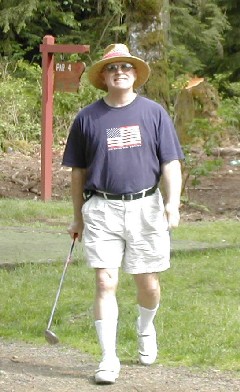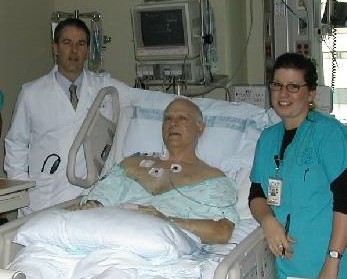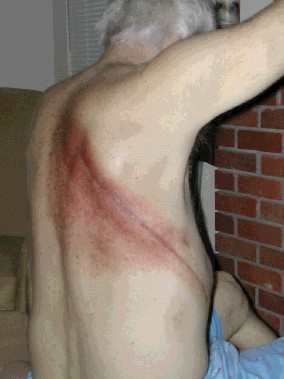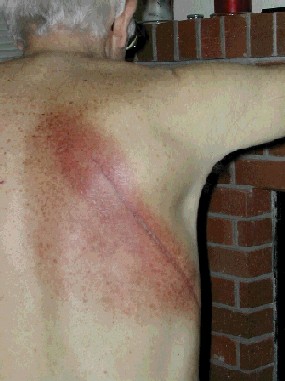Blueprint of Recovery
Robert Treggett is a man of purpose with a zeal for learning and living. In the fall of 2003 Bob was attending Northwest College in Kirkland, Washington with plans to graduate with a degree in Ministry Leadership in October of 2004. Due to his circumstances, that plan was put on hold during the winter semester of 2004.
Bob's troubles began on Wednesday September 3, 2003 with a visit to his family doctor for breathing difficulties. He was treated for possible bronchitis. Following an inclusive chest x-ray, Bob was given an inhaler with instructions to return when it was all used up and he was sent home.
By Sunday September 7, Bob's breathing was worse and he had a low-grade fever, so he presented himself at the emergency room of Northwest Hospital and Medical Center, fearing a case of pneumonia. It was determined at this time that Bob had a considerable amount of fluid in his right chest cavity. Bob was immediately admitted to the hospital and later that same day a thoracentesis was performed, draining off 120 cc's of fluid with the "biggest needle I've ever seen" from the right pleural cavity. The cytological testing of the pleural fluid was interpreted as malignant and consistent with adenocarcinoma. Immediately Bob consulted a local oncologist, who after reviewing the medical records felt further diagnostic testing was needed before mapping out a treatment plan. On September 16, 2003, Bob returned to Northwest Hospital and Medical Center where the surgeon performed a thoracoscopy, a diagnostic examination of the pleural cavity followed by a pleurodesis. During these procedures a few pieces of blood-stained, tan fibrous tissue were harvested and sent to pathology. The pathology report issued on September 23, 2003, showed an apparent atypical mesothelial proliferation in association with fibrotic reaction and inflammation. The differential diagnosis included malignant mesothelioma versus exuberant atypical but benign mesothelial reaction. Because of the inconsistency of the diagnosis, the pathologist sent the case to Dr. Samuel Hammar, an expert consultant pulmonary pathologist.
Dr. Samuel Hammar, a member of the U.S.-Canadian Mesothelioma Panel, diagnosed epithelial malignant mesothelioma.

With the diagnosis now confirmed, Bob was faced with the grim realization he was going to need the best medical care available along with his faith to fight this horrible cancer. His surgeon referred him to Dr. Eric Vallieres, a specialist in thoracic surgical oncology and the Surgical Director of the Lung Cancer Program at the Swedish Cancer Institute. Dr. Vallieres also serves on the Science Advisory Board of the Mesothelioma Applied Research Foundationwww.marf.org.
Bob's first consultation with Dr. Vallieres resulted in positive news. Dr. Vallieres felt Bob was a suitable candidate for surgery. Based on his examination and review of the medical records, Dr. Vallieres suggested immediate commencement of treatments which included chemotherapy followed by a right-sided extra-pleural pneumonectomy (EPP) and adjuvant radiation treatments. Dr. Vallieres insisted that Bob complete at least three rounds of chemotherapy, utilizing Alimta in combination with Cisplatin, before scheduling surgery.
On October 28, 2003, Bob began chemotherapy which was administered intravenously, one day every three weeks, at the Puget Sound Cancer Center in Seattle, Washington. The second and third days after treatment left him sick and nauseous. On November 6th a port was inserted to help administer future chemotherapy treatments. Bob weathered through the chemotherapy completing the last one on January 20, 2004. It was now time to determine if he remained a suitable candidate for the EPP.
Since a patient who undergoes an extra-pleural pneumectomy (EPP) is forced to survive on one lung, the patient's cardiac and pulmonary capacity must be fully evaluated prior to the surgery. Bob underwent all the necessary preoperative tests and after looking at other treatment alternatives available, Dr. Vallieres recommended that Bob go forward with the surgery. Dr. Vallieres explained to Bob that he would face at least two weeks of postoperative hospitalization and that the postoperative pain would be substantial. Dr. Vallieres assured Bob that he would be given adequate pain medication. But, Dr. Vallieres told Bob that he would also need to learn to cope with some pain and discomfort as he was weaned off the pain medication.
With all the facts in front of him, Bob agreed to the surgery. On February 23, 2004, Dr. Vallieres made the usual incision extending from beneath the scapula to below the nipple. He removed the 6th rib and opened up the chest cavity. After rolling the pleural sac away from the diaphragm, Dr. Vallieres removed Bob's entire right lung and diaphragm, a portion of the adherent pericardium and pleurae. The diaphragmatic and pericardial defects were closed with patches. Further pathological analysis of the tissue removed during the surgery confirmed the previous diagnosis of malignant epithelial mesothelioma and the presence of a tumor on the pericardium.
Postsurgically, Bob was troubled with atrial fibrillation. His recovery was guarded and difficult.

Since the surgery, Bob has only praises for the surgical skills of Dr. Vallieres. According to Bob, the surgical precision of Dr. Vallieres left only a few small areas of cancer cell activity. These areas were so obscure and minuscule that his radiology treatment plan had to be redesigned by his doctor. Bob completed his radiation treatments on June 18.
Bob states that he still has some residual pain from the surgery. Although, he had to take 60 mgs of morphine 24/7 for a whole month longer than expected and then 30 mgs at night for another month, he is now morphine-free and manages the low grade residual pain with doses of Percocet as needed. Prior to radiation treatment he was even able to regain enough strength to help his wife Linda with some work in the front yard, but only in a supervisory capacity.
With the past few months behind him, Bob is looking forward to his future. He anxiously awaits for his follow-up visit with Dr. Vallieres scheduled for late July. Bob is hopeful that Dr. Vallieres will provide the medical release necessary for him to return to work as a building maintenance supervisor. Bob desperately wants to return to work. The financial burden of his illness has been shouldered by Linda. Living on only one income has been difficult. Bob is also anxious to return to college and complete his degree. He hopes to return in February of 2005 and graduate the following October.
If you were to ask Bob about life before his diagnosis and life since, he would relate how he and Linda have been avid sailors and skiers since they met. When circumstances forced them to sell the sailboat and give up skiing they became golfers to fill the void. Now, even that has not been possible since Bob began his cancer treatments. Bob feels life will become pretty dull if he can no longer play golf or use his right arm for any kind of strenuous activity, as is presently the case. A fitting activity will have to be found to keep him and his wife of 15 years as active as they have been since their beginning.
*** POSTED JUNE 22, 2004 ***


The above pictures show the skin reaction (grade I) standard for medical radiation exposure on Bob's back June 29, 2004
An Update 6/2/06 (from the Treggetts)
The latest news for Bob's health:
This week he had a CT scan then met with his Pulmonist (lung doctor). The CT scan showed some renewed tumor activity. The last time we met with the surgeon, he noticed something suspicious on a CT scan Bob needed for another health issue not related to the cancer. With both scans it enabled the pulmonologist to compare, which showed that the spot originally noticed by the surgeon has now increased in size. The pulmonologist said it is probably inoperable because of the location, on the bottom of the remaining lung (left side).
On the good news side, Bob has been doing really well with his strength and stamina, being able to start working with a Physical Trainer at our athletic club to gain back some muscle tone that was lost during his recuperation. He is not required to use oxygen except at high altitudes which enables him to sleep.
He will be scheduled for a PET scan then will see the surgeon and possibly a conference with all doctors involved (will know more later). It is not yet known how we will proceed.
News on Bob's Education:
He graduated in May from Northwest University with a Bachelor's in Ministry Leadership. He graduated Magna Cum Laude and was nominated by the faculty to the Sigma Chi Pi Honor Society. He has started volunteering at our church, Overlake Christian Church, to help in the area of leadership training at OCC, around the corner, and around the world.(If you want to know more about our church, visit: www.occ.org).
Prayer Requests:
Wisdom for the doctors while diagnosing & treating.
For strength and stamina so Bob can be effective in his efforts.
An Update 6/14/06 (from the Treggetts)
Well the verdict from Science is in. I have a tumor on my left pleura. It is about the size of a large green pea. The doctors will be conferencing, as soon as the MRI I had today is available, and presenting my case to the tumor board. When I get home from vacation in July they will present me with my options which will pretty much be site-specific radiation (latest in difficult tumor treatment technology). Needless to say it is in-operable. Not the news we were all hoping for, but God is still on the throne and in control. For phase one treatment He used expert Doctors at all stages, for phase two treatment He will have to personally intervene if I'm to survive much beyond Jan., 1,2007.
Praises:
I feel good right now and am pretty healthy otherwise just like 34 months ago when this all started.
We will have a good vacation and family time in our Nation's Capitol later this month.
Prayer requests:
Please pray for Linda's back the disc problem is not getting any better and her discomfort comes and goes very randomly.
Pray for peace and stamina while we are on vacation.
Pray for strength and courage as I come home to do battle yet again with this cancer.
An Update 7/23/06 (from the Treggetts)
On 6/13/06 the pulmonologist had Bob undergo an MRI to find out how much tumor involvement there is. That night we left for a three-week family vacation to the East Coast. While we were out of town, the pulmonologist called Bob's cellphone and let us know the results of the MRI. The tumor on the lung was a definite, and there was also a new tumor on the spine.
On 7/10/06 we had an appointment with the Radiologist, Dr. Mehta, who was responsible for Bob's radiation treatment a couple of years ago. Dr Mehta stated that because Bob is not experiencing any pain he doesn't see any reason to treat the tumors with radiation at this time, which should only be considered when there is an onset of pain.
Upon Bob's inquiry as to whether the doctor knew of any studies underway for second-phase treatment, he referred us to an oncologist not previously seen by Bob since this doctor is involved in a clinical trial with a promising new drug for treatment of Mesothelioma. We found out from the Symposium we attended last year for MARF (Mesothelioma Applied Research Foundation) that once a patient has chemo with a certain drug cocktail that the same drugs should not be used again in the second round of treatment
On 7/19/06 we met with Bob's pulmonologist, Dr. Pappas, who confirmed that the oncologist we were referred to, is an excellent doctor and he has worked with him before. During the appointment, I mentioned that Bob had come down with a rash on his mid-section both front and back on the right side. After the doc looked at it, he said it was shingles which is a virus that lies dormant (from the chicken pox) and can occur at any time later in life. He was given medication to combat that.
On 7/21/06 we met with the new oncologist, Dr. Howard (Jack) West, and his research assistant, Shirley Raltz, RN. They covered with us the guidelines, side-effects, and paperwork connected with the chemo drug for this second-phase treatment called AZD2171. Since we were there and had no pressing appointments, they had Bob undergo some tests to provide a baseline for later comparison. He had a CT scan, EKG, blood work, checking also for kidney function.
If Bob is approved (which we don't see any reason why he should be rejected) he will be registered into the study and given chemo which is three 15mg pills taken orally. He will be required to document his pill intake, and document his blood pressure taken twice a day since one of the drug's side-effects can be high blood pressure. To monitor the effectiveness of the chemo on the tumors, for the first two months the same tests as those taken for the baseline will be done once each week, then thereafter, once a month.
Praises:
No pain from the tumors.
The shingles were caught early for treatment and now show signs of clearing up.
No IV chemo, so no extended clinic visits!
Prayer requests:
That we would have the grace to accept God's will.
We would like to take this opportunity to make you aware of the MARF non-profit organization that funds research grants to find a cure for this deadly asbestos-caused disease. You can visit their website at: http://www.marf.org to read stories of people affected by this disease and presentations of medical professionals at last year's Symposium. If you choose to make a financial donation to fund research into finding a cure for this life-ending disease, it is tax-deductible
An Update 10/10/06 (from the Treggetts)
Even though Bob is feeling as good now as he did three years ago, he is still grappling with the loss of the ability to do basic things. Lately, he has learned about the natural grieving process that comes with the loss of a body part (Bob's right lung was amputated). Originally, Bob was told he had a 39 month prognosis; that date is fast approaching - December 2006. But Bob is "not dead yet and has no intention of rolling over either." In mid-October 2006 he will begin missionary work, traveling first to South Africa then to Kenya in November where he will be joined by Linda. In February 2007 Bob plans to go to India and in May, to the Philippines. He plans to enjoy this time traveling and being with family.
While Bob doesn't have a lot of stamina, he says he can sit and talk for hours. His doctors will be monitoring the new spot on his left lung with CAT scans taken every four months. He still has some residual discomfort from the initial surgery where a rib was broken to remove his right lung. But even though Bob finds it difficult to put his carry-on bag overhead, he will continue to minister abroad, "God has trained me to travel overseas to train pastors and church leaders." Bob will not waste any time meanwhile, he says "it was hard enough just trying to sit around for three years recuperating."
*** Mr. Bob Treggett passed away on August 23, 2008 ***


